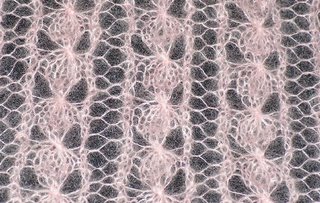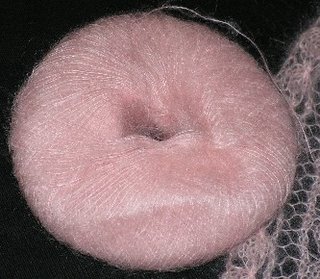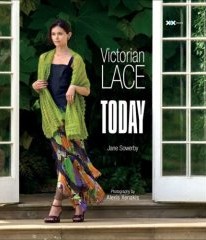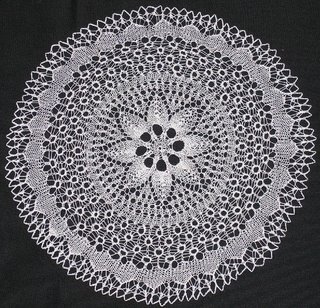Knitting with sewing thread

Pattern: "L" from Erich Engeln leaflet #1
Thread: DMC Tatting (6-cord cotton thread, size 80)
Needles: 1.5 mm
Pattern: #47 from Burda special 198
Thread: Coats and Clark #40 cotton sewing thread
Needles: 1.5 mm
I knit the fuschia doily with the DMC Tatting 80 first and then cast on and knit the white doily immediately after freeing my needles from the fushchia doily. The doilies were each about 50 rounds with fairly basic stitchmaking and were completed very quickly. I just wanted to see what knitting with finer thread would be like. These two doilies are the finest threads I've used so far now, and of course I'm still experimenting.
I know people joke that all knitted doilies must have been made with "wires and sewing thread," but I have also heard people remark, without joking, that crochet cotton in about size 50 is actually equivalent to "sewing thread" weight thread. That is not true. Even the usual threads from sewing kits are a lot finer than the typically used crochet cottons, even "size 50" crochet cotton. This picture shows the Engeln 7F doily in DMC Cordonnet 60 on the right and the Burda 198-47 doily in Coats and Clark #40 sewing thread on the left in the same shot for comparison.
So, those of you who are afraid to start knitting with crochet cotton--take heart! It really isn't like something you would put into a sewing machine.
Yet, I had to ask myself, what is knitting with actual sewing thread like? Well, it's surprisingly doable, especially when you have 1.5 mm circular needles! Not long ago, I used 1.5 mm (US 000) needles for the first time with DMC Cordonnet 60, and I realized that 1.5 mm needles would be small enough for threads at least a little finer than size 60 crochet cotton. As it turns out, I now think I could still use 1.5 mm needles with thread slightly finer than the #40 sewing thread.
Looking at spools of sewing thread, now I can see the confusion regarding "size 50" thread. The sewing thread is in fact labeled by sizes—#40, #50, #60—just like crochet cotton thread. But the size numbers clearly do not mean the same things in sewing thread and in crochet cotton. Having just knit with the #40 Coats and Clark thread, I can say it is definitely finer than the DMC Tatting size 80 thread, and it feels just a little finer than DMC Cordonnet 100.
I really want to compare sewing threads to crochet cotton threads by their respective yards per pound numbers, but I don't have enough information. Balls of crochet cotton are marked with yardage and weight, but spools of sewing thread only list yardages. The sewing thread size numbers might be related to the cotton count system (more info on that here, here, and here) but I'm not 100% sure that sewing thread marked "3-ply, #40" means it is actually "40/3 thread" under the cotton count system. So, maybe I'll just have to get a McMorran yarn balance soon to work out the numbers once and for all.
1.5 mm circular needles: Inox vs. Addi
After knitting Engeln 7F with grey Inox 1.5 mm circulars, I did purchase a pair of Addi Turbo 1.5 mm circulars. I still don't think the Inox ones (which cost only about half of the Addis) are bad, but yes, the join on Addis is much better. I think how much the join matters depends on several things, including your tension, but overall, I'm sure that the smoothness of the join becomes more important as the thread gets finer relative to the needle size. Also, it is always harder to scoot lace knitting across the join (when you have a bunch of yarn overs mixed with knit stitches on the needle) than all knit stitches in plain knitting. So, working lace knitting with the DMC Tatting 80 and #40 sewing thread, I think the smooth join of the Addi needles was essential and worth the extra $$$.
Sewing thread: Coats and Clark vs. other brands
In addition to the Coats and Clark #40 sewing thread, I plan to knit a few other basic sewing threads recommended for sewing and machine quilting, all 100% cotton. (I am not a quilter, but from what I understand, threads labelled as "hand-quilting thread" usually have a coating that makes hand sewing easier, so I deliberately avoided buying hand-quilting thread for knitting.)
The Coats and Clark #40 sewing thread I used to knit Burda 198/42 is very soft and somewhat fuzzy. I probably would not knit with this thread again, at least not any larger, more time-consuming pieces.
However, I've already begun knitting another small doily with Gütermann #50 machine quilting thread, and it feels sharp, crisp, and not at all fuzzy. So far, I'm very impressed! I'd say it's actually a lot like high quality crochet cotton, only finer, and the Gütermann thread is much higher in quality, from a knitting perspective at least, than the Coats and Clark thread.
There are also threads that are much finer than "regular" sewing thread, like cotton threads from sizes 80/2 to 170/2 listed in the catalogs of Lacis and other lacemaking suppliers. Although I would like to find out what is the finest thread that is knittable, I'm putting off buying any of these truly freakish materials for next time, after I explore knitting with some other regular sewing threads I currently have on hand.
In any case, I don't know how many pieces I would knit with these ultra-fine threads. I want to attempt a few just for the challenge and novelty of it, but as I've already seen with the Coats and Clark thread, not all threads make good, durable pieces. For me, that also means not all threads are worth investing the time and effort to knit into lace. I am more interested in finding and knitting the finest thread available that still has some resemblance to high quality crochet cotton in terms of durability and appearance.









